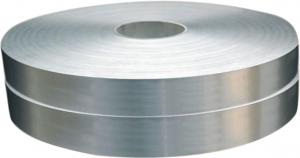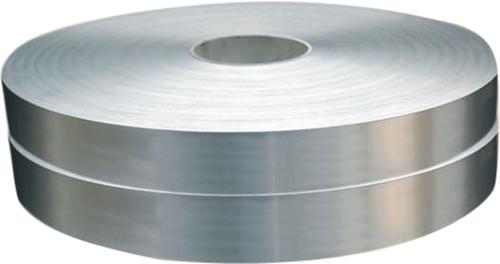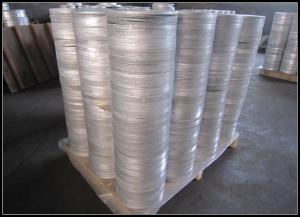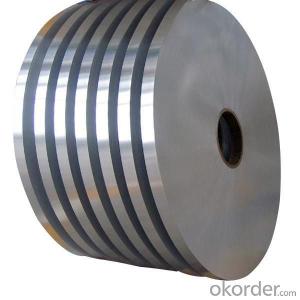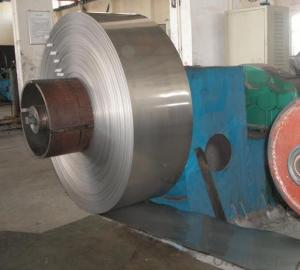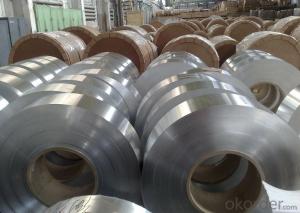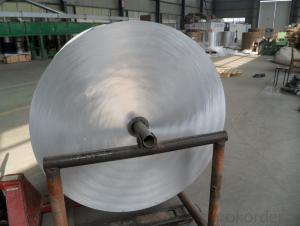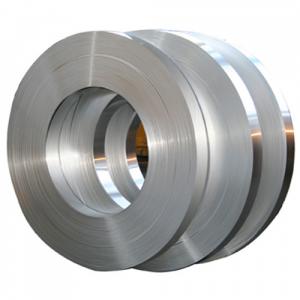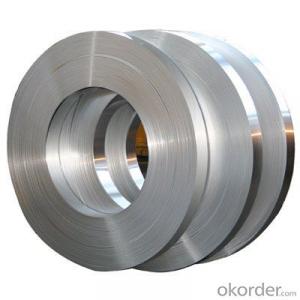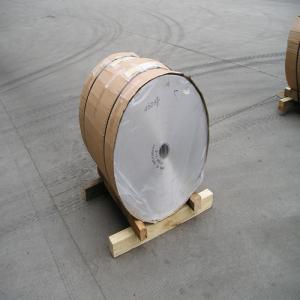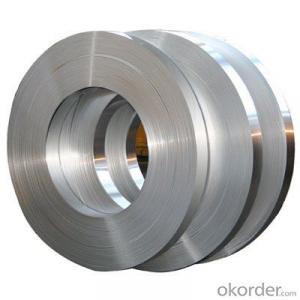Aluminum Strip for Transformer
- Loading Port:
- Shanghai
- Payment Terms:
- TT or LC
- Min Order Qty:
- -
- Supply Capability:
- 500 Tons kg/month
OKorder Service Pledge
OKorder Financial Service
You Might Also Like
1.Description
Aluminum strip is widely used in industry, especially for Asian market. Because the good anti heat and anti wet specification. it's very good for transformer.
2.Specification and Application
Specification
| Alloy | 1050/1060 |
| Temper | Soft |
| Process | DC / CC |
| Thickness | 0.5~0.8mm |
| Width | As required |
| Core ID | 505mm / 605mm |
Property
| Tensile strength | ≥100Mpa |
| Elongation | ≥15% |
| Tolerance of size | As GB Standard |
3. Advantages
We've been specialized in aluminium for more than ten years, we know this product very well, and we have good finacial support from government.
4. Pictures
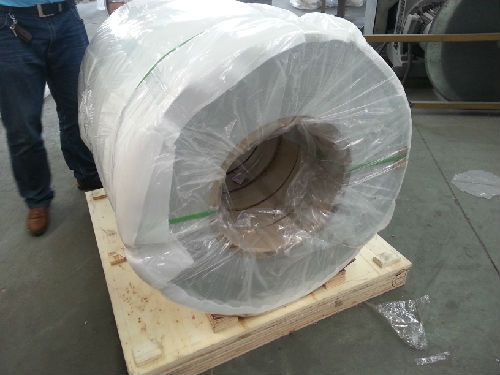
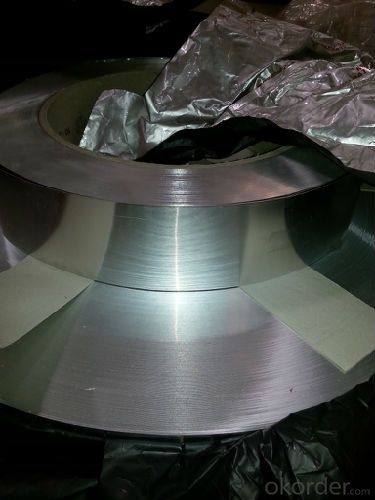
5. FAQ
1) What is your delivery time?
Our regular production time is over 30 days, It depends on the order quantity also.
2) What is your payment term?
We accept T/T, LC at sight, Usance LC 30, 60, 90, 120, 180 DAYS.
3) What is your price structure?
Our foil price is based on Shanghai Metal Price(SMM), not LME, but we could offer LME+ Conversion for your reference.
4) What is your minimum order quantity?
If regular size, it's 5tons per size, if not regular size, it's 8tons per size.
- Q: What characteristics of aluminum strips make them ideal for construction purposes?
- <p>Aluminum strips are suitable for use in construction due to several key properties. They are lightweight, which reduces the load on structures and makes them easier to handle and install. They possess high strength-to-weight ratio, ensuring durability and resistance to deformation. Aluminum strips are also corrosion-resistant, protecting against rust and other forms of decay, which is crucial for long-term structural integrity. Their excellent thermal conductivity aids in heat management, which is beneficial in both heating and cooling applications. Furthermore, aluminum strips are malleable and can be easily shaped and bent, allowing for versatile design and construction. Lastly, they are recyclable, contributing to sustainability and reducing environmental impact.</p>
- Q: This question asks for a step-by-step guide on how to attach aluminum strips to a roof, likely for decorative or protective purposes.
- <p>To install aluminum strips on a roof, follow these steps: 1. Clean the roof area where the strips will be installed to ensure a good adhesive bond. 2. Measure and cut the aluminum strips to the required length. 3. Apply a high-quality construction adhesive or sealant along the back of the aluminum strips. 4. Carefully position the strips onto the roof, pressing firmly to ensure proper adhesion. 5. Use a level to ensure the strips are straight and aligned. 6. Allow the adhesive to cure according to the manufacturer's instructions. 7. Seal any gaps or joints between the strips with additional sealant if necessary. 8. Inspect the installation to ensure all strips are securely in place. Safety precautions such as using a ladder and wearing protective gear should be observed throughout the process.</p>
- Q: Is it possible to use aluminum strips to construct a solar reflector system for residential or commercial purposes?
- <p>Yes, you can use aluminum strips to create a solar reflector system for your home or business. Aluminum is a reflective material and can be shaped into strips to reflect sunlight. These strips can be arranged in a way to direct sunlight towards solar panels or into specific areas to reduce the need for artificial lighting and heating. However, for optimal efficiency, you should consider the angle of reflection, the positioning of the strips relative to the sun's path, and the overall design of the system. Consulting with a professional in solar technology can help ensure that your solar reflector system is effective and safe.</p>
- Q: What precautions should be taken while handling aluminum strips to ensure safety?
- <p>When using aluminum strips, it's important to follow safety measures to prevent injury or damage. Always wear protective gloves and eyewear to protect against sharp edges and flying debris. Ensure good ventilation to avoid inhaling aluminum dust, which can be harmful. Avoid using aluminum strips near open flames or high heat sources as aluminum can melt and cause burns. Keep aluminum strips away from corrosive chemicals that can react with it. Store aluminum strips properly to prevent damage and ensure they are dry to avoid rusting. Always follow the manufacturer's guidelines for safe handling and usage.</p>
- Q: Is it possible to use recycled adhesive to attach aluminum strips?
- <p>Using recycled adhesive to install aluminum strips is generally not recommended. Recycled adhesive may have reduced adhesive properties due to previous use, which could compromise the bond's strength and durability. It's crucial to use a new adhesive specifically designed for the material and application to ensure a secure and long-lasting installation. Always follow the manufacturer's guidelines for the best results.</p>
- Q: What are the specific types of aluminum strips that are frequently utilized in the construction industry?
- <p>Yes, there are several special types of aluminum strips commonly used in construction. These include aluminum flashing strips for waterproofing and sealing, aluminum trim strips for finishing edges and corners, and aluminum heat sinks for heat dissipation in electrical installations. Additionally, aluminum strips are used in curtain wall systems, window frames, and as reinforcement in concrete structures. The choice of aluminum strip depends on the specific requirements of the construction project, such as strength, durability, and resistance to corrosion.</p>
- Q: This question asks about the ease of installation for aluminum strips.
- <p>Aluminum strips are generally easy to install. They are lightweight and can be cut to size with basic tools. Installation usually involves peeling off a protective backing and adhering the strip to a clean, dry surface. For best results, it's important to ensure the surface is free of dust and grease. Some types of aluminum strips may require additional fasteners or adhesive for a secure fit, but overall, the process is straightforward and can be done by most DIYers with a little patience and attention to detail.</p>
- Q: Is it possible to use aluminum strips as a roofing material in regions with cold weather conditions?
- <p>Yes, aluminum strips can be used for roofing in cold climates. Aluminum is a durable and lightweight material that is resistant to corrosion and weathering, making it suitable for various climates, including cold ones. It doesn't rust and can withstand heavy snow loads. However, it's important to consider the thermal properties of aluminum, as it conducts heat and cold efficiently, which may necessitate additional insulation to maintain the desired indoor temperature. Additionally, proper installation and underlayment are crucial to prevent moisture and heat loss.</p>
- Q: Is it possible to utilize recycled aluminum strips for construction purposes?
- <p>Yes, you can use recycled aluminum strips in your construction projects. Recycled aluminum is not only environmentally friendly but also cost-effective. It maintains the same strength and durability as new aluminum, making it suitable for various construction applications such as framing, roofing, and cladding. However, it's crucial to ensure that the recycled aluminum meets the required industry standards and specifications for your project to guarantee safety and performance. Always consult with a professional or engineer to confirm the suitability of recycled aluminum for your specific construction needs.</p>
- Q: This question asks about the potential environmental effects resulting from the use of aluminum strips.
- <p>The environmental impacts of using aluminum strips include energy-intensive production processes that contribute to greenhouse gas emissions, potential water pollution from manufacturing, and solid waste generation. Aluminum production requires significant amounts of electricity, often from non-renewable sources, which can exacerbate climate change. Additionally, the mining and refining of bauxite, the primary source of aluminum, can lead to habitat destruction and water contamination. However, aluminum is also highly recyclable, and recycling reduces energy consumption and waste. The overall environmental impact depends on the balance between production, use, and recycling practices.</p>
Send your message to us
Aluminum Strip for Transformer
- Loading Port:
- Shanghai
- Payment Terms:
- TT or LC
- Min Order Qty:
- -
- Supply Capability:
- 500 Tons kg/month
OKorder Service Pledge
OKorder Financial Service
Similar products
Hot products
Hot Searches
Related keywords
